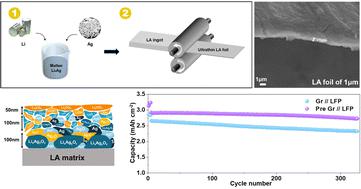当前位置:
X-MOL 学术
›
Energy Environ. Sci.
›
论文详情
Our official English website, www.x-mol.net, welcomes your
feedback! (Note: you will need to create a separate account there.)
Non-sticky Li-alloy leaves for long-lasting secondary batteries
Energy & Environmental Science ( IF 32.4 ) Pub Date : 2022-10-19 , DOI: 10.1039/d2ee02135h Can Zhang 1, 2 , Huimin Fan 1, 2 , Xinlong Chen 1, 2 , Hui Xu 3 , Jiatao Lou 4 , Yao Li 5 , Yunhui Huang 1, 2 , Sa Li 1, 2
Energy & Environmental Science ( IF 32.4 ) Pub Date : 2022-10-19 , DOI: 10.1039/d2ee02135h Can Zhang 1, 2 , Huimin Fan 1, 2 , Xinlong Chen 1, 2 , Hui Xu 3 , Jiatao Lou 4 , Yao Li 5 , Yunhui Huang 1, 2 , Sa Li 1, 2
Affiliation

|
Metal foils are used for packaging and decoration, and gold leaf down to 0.1 μm thickness has been made since ancient Egyptian times. The chemical inertness of gold, causing non-stickiness, and its malleability, underlie the success of “Goldbeating”. In contrast, lithium metal is extremely reactive and sticks to rollers as well as degrades in air. How to make one-to-few μm thick, large-area lithium foil is a key challenge for the battery industry, as such foils can provide extraordinarily longer cycle life to rechargeable batteries when standard anodes such as graphite or silicon are prelithiated right before cell assembly, by mechanically pressing the thin foil to the anode. Here, we show that the addition of a small alloy-element on the order of 1 at% to the body-centered cubic (BCC) phase drastically changes the oxidized surface layer composition, making the Li alloy much less sticky towards the rolling machine. By forming a protective passivation layer, the air stability is dramatically enhanced, so it can be stored for up to 12 hours without significant performance degradation. Also, there is a 10× strengthening effect, making the sheet much less prone to ductile rupture damage during rolling, while maintaining malleability. As a result, we are able to fabricate large-area lithium foil in a roll-to-roll manner down to 1 μm thickness. Such an ultra-thin Li foil anode demonstrates superior electrochemical performance directly in pouch cells (>320 W h kg−1), in which the 0.8 A h pouch-cell achieved a 100 cycle life under lean electrolyte conditions of 2.67 g A h−1. Furthermore, we applied 5 μm Li to graphite prelithiation, having an extra 1 mA h cm−2 lithium inventory (the amount of cyclable lithium in a full cell), the capacity of the LFP//graphite full cell increases by 18%, with an average coulombic efficiency of >99.99% over more than 300 cycles.
中文翻译:

用于长效二次电池的非粘性锂合金叶片
金属箔用于包装和装饰,从古埃及时代就制作了厚度低至0.1微米的金箔。黄金的化学惰性、不粘性和延展性是“打金”成功的基础。相比之下,锂金属具有极强的反应性,会粘在滚筒上并在空气中降解。如何制造一到几微米厚的大面积锂箔是电池行业面临的一个关键挑战,因为当石墨或硅等标准阳极在电池之前进行预锂化时,这种箔可以为可充电电池提供非常长的循环寿命组装,通过机械地将薄箔压到阳极上。这里,我们表明,在体心立方 (BCC) 相中添加约 1 at% 的少量合金元素会显着改变氧化的表面层组成,使锂合金对轧制机的粘性大大降低。通过形成保护性钝化层,空气稳定性显着增强,因此可以存放长达 12 小时而不会显着降低性能。此外,还有 10 倍的强化效果,使板材在轧制过程中不易发生延展性断裂损坏,同时保持延展性。因此,我们能够以卷对卷的方式制造厚度低至 1 微米的大面积锂箔。这种超薄锂箔负极直接在软包电池中表现出优异的电化学性能(>320 W h kg 使锂合金对轧制机的粘性大大降低。通过形成保护性钝化层,空气稳定性显着增强,因此可以存放长达 12 小时而不会显着降低性能。此外,还有 10 倍的强化效果,使板材在轧制过程中不易发生延展性断裂损坏,同时保持延展性。因此,我们能够以卷对卷的方式制造厚度低至 1 微米的大面积锂箔。这种超薄锂箔负极直接在软包电池中表现出优异的电化学性能(>320 W h kg 使锂合金对轧制机的粘性大大降低。通过形成保护性钝化层,空气稳定性显着增强,因此可以存放长达 12 小时而不会显着降低性能。此外,还有 10 倍的强化效果,使板材在轧制过程中不易发生延展性断裂损坏,同时保持延展性。因此,我们能够以卷对卷的方式制造厚度低至 1 微米的大面积锂箔。这种超薄锂箔负极直接在软包电池中表现出优异的电化学性能(>320 W h kg 使板材在轧制过程中不易发生延展性断裂损坏,同时保持延展性。因此,我们能够以卷对卷的方式制造厚度低至 1 微米的大面积锂箔。这种超薄锂箔负极直接在软包电池中表现出优异的电化学性能(>320 W h kg 使板材在轧制过程中不易发生延展性断裂损坏,同时保持延展性。因此,我们能够以卷对卷的方式制造厚度低至 1 微米的大面积锂箔。这种超薄锂箔负极直接在软包电池中表现出优异的电化学性能(>320 W h kg-1 ),其中 0.8 A h 袋式电池在 2.67 g A h -1的贫电解质条件下实现了 100 次循环寿命。此外,我们将 5 μm Li 应用于石墨预锂化,具有额外的 1 mAh cm -2锂库存(全电池中可循环锂的量),LFP//石墨全电池的容量增加了 18%,超过 300 次循环的平均库仑效率 > 99.99%。
更新日期:2022-10-19
中文翻译:

用于长效二次电池的非粘性锂合金叶片
金属箔用于包装和装饰,从古埃及时代就制作了厚度低至0.1微米的金箔。黄金的化学惰性、不粘性和延展性是“打金”成功的基础。相比之下,锂金属具有极强的反应性,会粘在滚筒上并在空气中降解。如何制造一到几微米厚的大面积锂箔是电池行业面临的一个关键挑战,因为当石墨或硅等标准阳极在电池之前进行预锂化时,这种箔可以为可充电电池提供非常长的循环寿命组装,通过机械地将薄箔压到阳极上。这里,我们表明,在体心立方 (BCC) 相中添加约 1 at% 的少量合金元素会显着改变氧化的表面层组成,使锂合金对轧制机的粘性大大降低。通过形成保护性钝化层,空气稳定性显着增强,因此可以存放长达 12 小时而不会显着降低性能。此外,还有 10 倍的强化效果,使板材在轧制过程中不易发生延展性断裂损坏,同时保持延展性。因此,我们能够以卷对卷的方式制造厚度低至 1 微米的大面积锂箔。这种超薄锂箔负极直接在软包电池中表现出优异的电化学性能(>320 W h kg 使锂合金对轧制机的粘性大大降低。通过形成保护性钝化层,空气稳定性显着增强,因此可以存放长达 12 小时而不会显着降低性能。此外,还有 10 倍的强化效果,使板材在轧制过程中不易发生延展性断裂损坏,同时保持延展性。因此,我们能够以卷对卷的方式制造厚度低至 1 微米的大面积锂箔。这种超薄锂箔负极直接在软包电池中表现出优异的电化学性能(>320 W h kg 使锂合金对轧制机的粘性大大降低。通过形成保护性钝化层,空气稳定性显着增强,因此可以存放长达 12 小时而不会显着降低性能。此外,还有 10 倍的强化效果,使板材在轧制过程中不易发生延展性断裂损坏,同时保持延展性。因此,我们能够以卷对卷的方式制造厚度低至 1 微米的大面积锂箔。这种超薄锂箔负极直接在软包电池中表现出优异的电化学性能(>320 W h kg 使板材在轧制过程中不易发生延展性断裂损坏,同时保持延展性。因此,我们能够以卷对卷的方式制造厚度低至 1 微米的大面积锂箔。这种超薄锂箔负极直接在软包电池中表现出优异的电化学性能(>320 W h kg 使板材在轧制过程中不易发生延展性断裂损坏,同时保持延展性。因此,我们能够以卷对卷的方式制造厚度低至 1 微米的大面积锂箔。这种超薄锂箔负极直接在软包电池中表现出优异的电化学性能(>320 W h kg-1 ),其中 0.8 A h 袋式电池在 2.67 g A h -1的贫电解质条件下实现了 100 次循环寿命。此外,我们将 5 μm Li 应用于石墨预锂化,具有额外的 1 mAh cm -2锂库存(全电池中可循环锂的量),LFP//石墨全电池的容量增加了 18%,超过 300 次循环的平均库仑效率 > 99.99%。











































 京公网安备 11010802027423号
京公网安备 11010802027423号